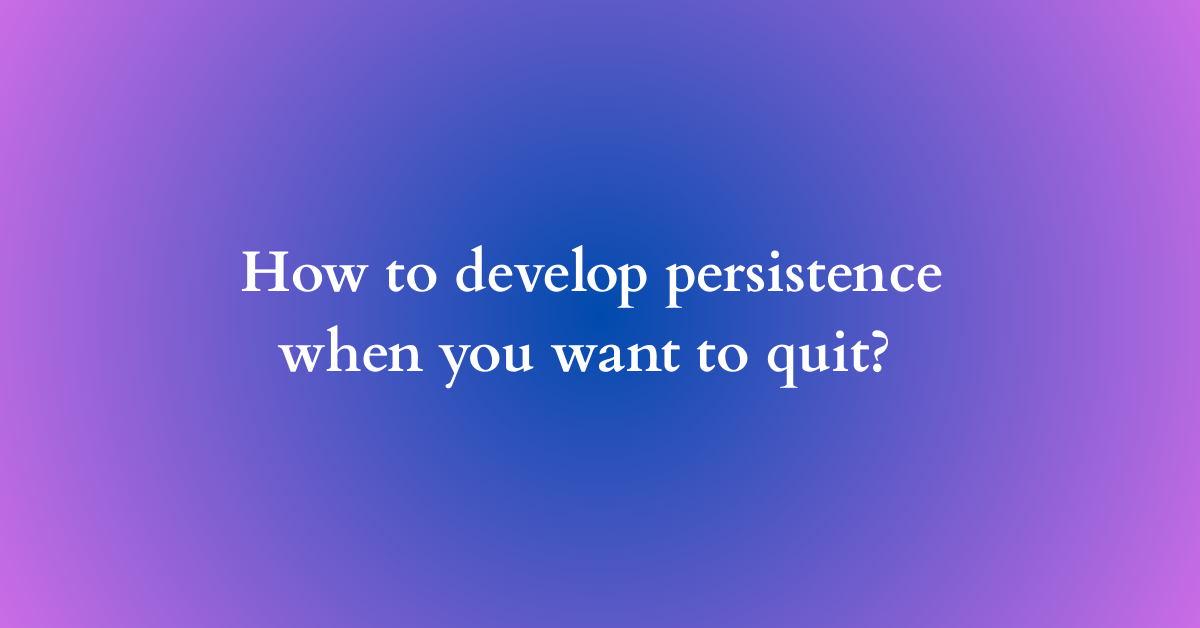How to develop persistence when you want to quit?
Digging Deep: How to Cultivate Persistence When You Feel Like Quitting
We’ve all been there. That gnawing feeling, that overwhelming urge to throw in the towel. Whether it’s a challenging project at work, a difficult fitness goal, a personal endeavor that seems insurmountable, or even a long-term relationship strained by challenges, the desire to quit is a powerful and seductive force. It whispers promises of immediate relief, of shedding the burden of effort, and of escaping the discomfort of struggle.
But surrendering to that impulse often comes with a price: regret, unrealized potential, and a lingering sense of “what if.” Persistence, on the other hand, is the bedrock of achievement. It’s the unwavering commitment to pushing through adversity, the resilient spirit that refuses to be defeated by setbacks. While quitting might feel like the easy option in the moment, cultivating persistence is the key to unlocking long-term success and a deeper sense of personal fulfillment.
So, how do we develop this vital trait, especially when the urge to quit is at its strongest? It’s a complex process that involves a multifaceted approach, incorporating mental strategies, practical techniques, and a deep understanding of ourselves.
1. Understand Your “Why”: The Foundation of Persistence
Before you can even begin to develop persistence, you need to clearly define your motivation. Why are you pursuing this goal in the first place? What personal values does it align with? What long-term benefits will it provide? Without a strong and compelling “why,” the inevitable obstacles will quickly erode your resolve.
Take the time to articulate your reasons for pursuing this goal. Write them down. Visualize the positive outcomes. Connect emotionally with the potential rewards. This deeper understanding of your motivation will serve as your anchor when the seas of doubt and frustration threaten to pull you under.
Consider these questions:
- What initially inspired you to pursue this goal?
- What positive impact will achieving this goal have on your life? On the lives of others?
- How does this goal align with your core values and beliefs?
- What will you feel like when you finally achieve this goal?
Regularly revisit your “why.” Keep it top of mind. When you’re feeling overwhelmed, remind yourself of the profound reasons that drove you to start. This act of reaffirmation can be a powerful antidote to the urge to quit.
2. Break It Down: Conquering Overwhelm Through Incremental Progress
Often, the feeling of wanting to quit stems from being overwhelmed by the sheer magnitude of the task ahead. The goal seems too large, the path too arduous, and the finish line too distant. To combat this, adopt the strategy of breaking down the overall goal into smaller, more manageable steps.
Think of it like climbing a mountain. You wouldn’t attempt to scale the summit in a single bound. Instead, you’d focus on reaching the next plateau, then the next, and the next. Each small victory builds momentum, reinforces your belief in your abilities, and keeps you moving forward.
- Identify the key milestones along the way.
- Break down each milestone into actionable tasks.
- Prioritize these tasks based on importance and urgency.
- Celebrate each small victory along the way.
By focusing on these smaller, achievable tasks, you’ll gradually chip away at the larger goal, making it seem less daunting and more attainable.
3. Cultivate a Growth Mindset: Embracing Challenges as Opportunities
Carol Dweck’s research on the growth mindset versus the fixed mindset provides valuable insights into how we approach challenges and setbacks. A fixed mindset believes that abilities are inherent and unchangeable, leading to a fear of failure and a tendency to avoid difficult tasks. A growth mindset, on the other hand, embraces challenges as opportunities for learning and growth.
Cultivating a growth mindset is crucial for developing persistence. It allows you to view setbacks not as evidence of your inadequacy but as valuable learning experiences. Instead of saying “I can’t do this,” you might say “I haven’t figured this out yet.”
Here’s how to cultivate a growth mindset:
- Embrace challenges: Actively seek out opportunities to step outside your comfort zone.
- View setbacks as learning opportunities: Analyze what went wrong and identify areas for improvement.
- Focus on effort and progress: Acknowledge and celebrate your hard work, even if you haven’t reached your goal yet.
- Learn from the success of others: Identify the strategies and habits that successful individuals have adopted.
- Replace negative self-talk with positive affirmations: Challenge limiting beliefs and replace them with empowering statements.
By adopting a growth mindset, you’ll be better equipped to persevere through adversity and view setbacks as opportunities to learn and grow stronger.
4. Build a Support System: Leveraging the Power of Connection
Going it alone can be incredibly isolating, especially when facing significant challenges. Building a strong support system is essential for maintaining motivation and resilience. Surround yourself with people who believe in you, who offer encouragement and support, and who can provide valuable advice and perspective.
Your support system might include:
- Friends and family: Share your goals and challenges with loved ones and seek their emotional support.
- Mentors and coaches: Seek guidance from individuals who have achieved success in your field or who possess expertise in the area you’re struggling with.
- Peers and colleagues: Connect with others who are pursuing similar goals and share your experiences and insights.
- Online communities: Participate in online forums or groups related to your interests and connect with like-minded individuals.
Don’t be afraid to ask for help when you need it. Sharing your struggles with others can alleviate the burden and provide you with fresh perspectives and solutions.
5. Practice Self-Care: Prioritizing Your Well-being
When you’re pushing yourself to achieve a goal, it’s easy to neglect your own well-being. However, neglecting self-care can lead to burnout, exhaustion, and a decreased ability to persevere. Prioritizing self-care is essential for maintaining your physical, mental, and emotional health, which in turn will fuel your persistence.
Self-care can take many forms, including:
- Getting enough sleep: Aim for 7-8 hours of quality sleep each night.
- Eating a healthy diet: Fuel your body with nutritious foods that provide sustained energy.
- Exercising regularly: Physical activity releases endorphins, which have mood-boosting effects.
- Practicing mindfulness and meditation: Take time each day to quiet your mind and focus on the present moment.
- Engaging in activities you enjoy: Make time for hobbies and activities that bring you joy and relaxation.
- Setting boundaries: Learn to say “no” to commitments that drain your energy and protect your time for self-care.
Remember, you can’t pour from an empty cup. Prioritizing self-care will allow you to recharge and maintain the energy and focus you need to persevere.
6. Embrace Imperfection: Letting Go of the Need for Perfection
Perfectionism is a common enemy of persistence. The relentless pursuit of flawlessness can lead to procrastination, fear of failure, and ultimately, giving up altogether. It’s important to recognize that perfection is an unattainable ideal and that striving for excellence is far more sustainable.
Embrace imperfection by:
- Accepting that mistakes are inevitable: View them as learning opportunities rather than failures.
- Focusing on progress, not perfection: Celebrate your accomplishments, no matter how small.
- Letting go of unrealistic expectations: Set achievable goals and be kind to yourself when you fall short.
- Practicing self-compassion: Treat yourself with the same kindness and understanding you would offer a friend.
By letting go of the need for perfection, you’ll free yourself from unnecessary pressure and create a more sustainable path towards achieving your goals.
7. Visualize Success: Harnessing the Power of Mental Imagery
Visualization is a powerful technique that can help you develop persistence by strengthening your belief in your ability to succeed. By mentally rehearsing your success, you’ll be more likely to persevere through challenges and achieve your goals.
To effectively visualize success:
- Find a quiet place where you can relax and focus.
- Close your eyes and imagine yourself achieving your goal.
- Engage all your senses: See yourself succeeding, hear the sounds of celebration, feel the emotions of accomplishment.
- Visualize the process, not just the outcome: Imagine yourself overcoming obstacles and persevering through challenges.
- Practice visualization regularly: Even a few minutes each day can make a significant difference.
By visualizing success, you’ll reinforce your belief in your abilities, strengthen your motivation, and increase your chances of achieving your goals.
8. Reward Yourself: Acknowledging Progress and Maintaining Motivation
Persistence is a marathon, not a sprint. It requires sustained effort over an extended period of time. To stay motivated and engaged, it’s important to reward yourself for your progress along the way. These rewards don’t have to be extravagant. They can be simple pleasures that acknowledge your hard work and provide you with a sense of accomplishment.
Consider these reward ideas:
- Treat yourself to a relaxing massage or spa day.
- Go out for a nice dinner with friends or family.
- Buy yourself something you’ve been wanting.
- Take a weekend getaway.
- Simply acknowledge your progress and celebrate your accomplishments.
Rewarding yourself for your efforts will reinforce positive behaviors, boost your motivation, and help you stay on track towards achieving your goals.
9. Reframe Failure: Learning from Setbacks and Moving Forward
Failure is an inevitable part of the journey towards success. It’s how you respond to failure that ultimately determines whether you achieve your goals. Instead of viewing failure as a sign of your inadequacy, reframe it as a valuable learning opportunity.
When you experience a setback, take the time to analyze what went wrong. Identify the lessons you can learn and apply them to future endeavors. Don’t dwell on your mistakes. Instead, focus on what you can do differently next time.
Remember, even the most successful individuals have experienced failure. The key is to learn from your mistakes, dust yourself off, and keep moving forward.
10. Remember the Alternative: The Cost of Quitting
Finally, when the urge to quit is overwhelming, take a moment to consider the alternative. What will your life look like if you give up on your goal? What opportunities will you miss out on? What regrets will you carry with you?
Visualizing the potential consequences of quitting can be a powerful motivator to persevere. Remind yourself of the reasons why you started in the first place and the positive impact that achieving your goal will have on your life.
Ultimately, developing persistence is a lifelong journey. It requires conscious effort, a willingness to learn and grow, and a deep commitment to your goals. By implementing these strategies, you can cultivate the resilience and determination you need to overcome adversity and achieve your full potential. So, dig deep, remember your “why,” and never give up on your dreams. Your future self will thank you for it.








